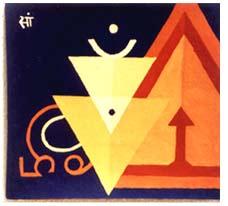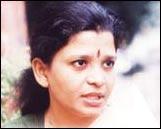

"I wish to emphasize the role of the thumb and the forefinger in the exercise of art. It is called the 'Chin Mudra' and often used as a gesture for meditation. It is seen with deities in Indian and Buddhist art and indicates the activating of consciousness or intellect.
"While painting or drawing, one employs these two fingers mainly, and it is believed to kindle the acupressure point related to the brain. Thus, through acupressure points, art therapy offers an individual means of escape from physical or mental stress and pain through intense concentration and involvement it calls for."
Rajny Krishnan, an artist and a sculptor, describes art therapy in the above words. We are at the 'Silver Lining Therapeutic Art Exhibition', which is being hosted by Manasthala, a non-governmental organisation located at Cenotaph Road in southern Chennai, where the works of her father, M V Krishnan, who suffers from Parkinson's disease, are being exhibited. The exhibition was held in November 2002.
Rajny, who calls herself an "art therapist", journey into art as therapy started over 15 years ago when she first began working with physically and mentally challenged children. Rajny wanted to find out how many of those who handle drawing pens and brushes every day use it as a tool to speak to, soothe, or rediscover themselves?
"A unified approach to art must be ruled out at the outset since its depths cannot be easily gauged and most art is period, location, religion and culture specific," said Rajny. She realised early on that art therapy could not, and need not, enjoy the same status as art per se. "The goal is self expression and healing," she added.
After training herself in the technical aspects of art therapy through reading and research, Rajny began to work with children through workshops. And discovered in one of her workshops for the physically and mentally challenged children that impairments of hearing, movement, or intelligence were of little importance or handicap in the children expressing themselves.
"Art therapy need not be painting alone. It can be music, it can be dance, it can be any other art. And art can heal," she insisted.
 Little did Rajny (left) think then that one day she would be trying the same therapy on her father. M V Krishnan, a active strong-willed person, met with a road accident in 1989. Although he survived, he began displaying curious symptoms, which in 1994, when he was then 62, was diagnosed as 'post-traumatic Parkinson's disease'. Gradually his speech, writing, mobility, and even sleep became affected and in 1997, the doctors confirmed that he was suffering from 1997 Parkinson's disease.
Little did Rajny (left) think then that one day she would be trying the same therapy on her father. M V Krishnan, a active strong-willed person, met with a road accident in 1989. Although he survived, he began displaying curious symptoms, which in 1994, when he was then 62, was diagnosed as 'post-traumatic Parkinson's disease'. Gradually his speech, writing, mobility, and even sleep became affected and in 1997, the doctors confirmed that he was suffering from 1997 Parkinson's disease.
The fact that he was immobile affected Krishnan very badly, who couldn't bear the 'freezing' episodes or the involuntary movements of his body. His family could only remain mute witnesses to the mental agony and physical discomfort he was going through.
Person suffering from the Parkinson's disease are unable to control their movements, which makes it difficult for them to perform simple daily tasks such as getting up from beds, brushing their teeth, washing up, walking, talking, or even sleeping. Writing becomes extremely difficult and scribbling is what appears.
Unable to bear her father's agony, Rajny decided to try art therapy on him. "From my childhood, I had admired my father's beautiful handwriting, his precision in plotting an industrial diagram and that he did everything perfectly. He was not an artist but I decided to gift him with colours and material," she said.
Encouraged by the way his hands responded when told to do some colouring work, Rajny supplied more and more colours and materials to him. Although his handwriting had become a scrawl, in no time he developed an amazing control in his colouring work.
Rajny stresses the fact that a patient need not know how to draw or paint, or learn the lessons of art. He only has to follow what the instructor tells him and his own instinct. Often, some art, according to Rajny, does not even require the constant involvement of the therapist.
"According to me, the role of the therapist is primarily to observe and facilitate suitable self-expression in an apt environment. All the other factors vary from case to case," she declared.
"My father realised that he had to rediscover and live more fully that part of himself again," recalled Rajny. "As he is a very spiritual person, I bought him reference materials on yantra and tantra as well as on the power of lines and colours. He preferred creating pictures that have a meditative quality."
Needless to say, Krishnan found new vigour in himself, something that was not missed by his family. "We began to notice changes in him. When he painted with concentration, his dyskinesias or involuntary movements were reduced. He could manage to point his brush at one place and that was a big achievement. At first, he would regret spoiling a painting. We then had to quickly move on to the next painting as he did not want to reveal flaws that spoke of his condition," said Rajny.
Two years ago, Krishnan, began to sit for hours, thinking and sketching, unmindful of his discomforts and body aches. Soon his painting acquired a focus and he began spending the best part of his day with colours. So much so, that Rajny decided to exhibit her father's work at Manasthala, which is involved in the promotion of Indian culture through the medium of traditional arts and crafts
An excited and proud Krishnan travelled to Manasthala and sat through the inauguration. He spoke of his long journey without any difficulty, though by the time he reached home, he had to be carried in. "Painting in spite of my condition of either 'freezing' or uncomfortable movements, slurred speech, fleeting concentration and troubled mind, has given me peace, hope and a sense of achievement. Now after two years of painting, my control and concentration have improved incredibly..." he had said in his speech, that was for the most part clear and coherent.
As I was talking to Rajny, I noticed a lady sitting on a chair in the middle of the exhibition hall, trying to concentrate on the paintings on the wall. She was Kalpana, 39, another Parkinson's disease patient who was completely immobile till recently. Her case was severe and she found it difficult to speak even a few words or move her limbs.
Yet, as I pored over a sheaf of her paintings of beautiful flowers in bewitching colours, I couldn't believe that they were painted by this lady who looked totally helpless and whose body shook with violent involuntary spasms in front of strangers.
Kalpana became a victim of Juvenile Parkinon's diseaseat the age of 15. Tragically, wrong diagnosis made her immobile and bedridden, and till a few years ago, her limbs were extremely stiff.
A newspaper article about her brought Rajny to her house, and she volunteered to help Kalpana through art therapy. It was an enlightening experience for Kalpana to hold a brush after more than two decades.
"Kalpana is a born artist, who had done quite a few paintings before she was affected by the disease," said Rajny, "She has seen even more trauma than my father. Now, she views my father as role model. After we started art therapy, she has learnt to use her right hand to paint, eat, and drink, and with her strong willpower, she even manages to walk a few steps without support. I feel so happy to see her a changed person once she starts painting."
Rajny has created the Krishna Nupur Cultural Trust for the work that she does with children, and through the trust, she provides the children with art material.
Rajny feels that painting will help Kalpana face the future, a thought that haunts her aging parents. "I am sure Kalpana can lead a comfortable and independent life as an artist. She can lead her own life. This is my conviction, and everything is going according to plans," said Rajny confidently.
Rajny intends to hold an exhibtion of Kalpana's paintings, but a little later. "I don't want anybody to view her paintings sympathetically just because she is afflicted with a disease," declared Rajny, "She is a born artist and she should get credit for her work."
Rajny Krishnan can be contacted at rajnykrishnan@yahoo.com
Design by Rahil Sheikh; photographs by Sreeram Selvaraj





